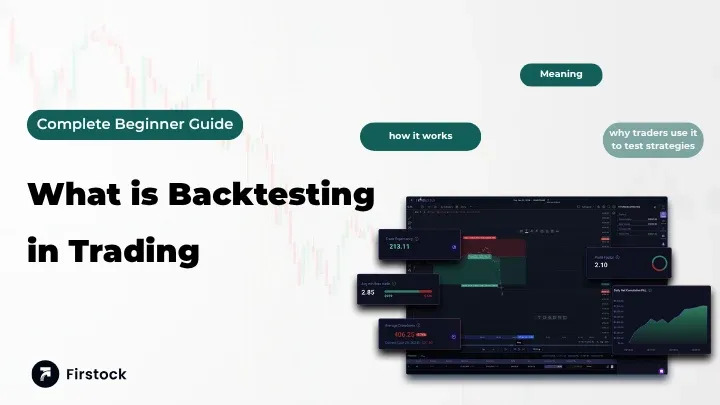Back Testing in Trading: A Complete Guide for Beginners
Introduction
Have you ever wished you could look into the past to predict your trading future? That’s exactly what back testing in trading helps you do! It’s like having a time machine that lets you test your trading ideas on old market data before risking real money. Whether you’re a beginner or an experienced trader, understanding what is back testing intrading and how to use it effectively can make a huge difference in your trading journey.
In this article, we’ll dive deep into back testing strategies, the process, tools, and the best trading apps in India that make back testing easier than ever. So, grab a cup of coffee and let’s decode this powerful concept together.
Learn what is back testing intrading, best back testing strategies, and how to use a trading app in India for back testing intrading effectively.
What is Back Testing in Trading?
Back testing in trading is the process of evaluating a trading strategy using historical market data to see how it would have performed in the past. Imagine you’ve created a new trading rule—say, buy a stock when its 50-day moving average crosses above the 200-day average. Before putting your money on the line, you can apply this rule to past data to test its performance.
Simply put, back testing helps you answer one big question: Would my strategy have worked before?
It’s a scientific way of verifying whether your trading plan makes sense—before using it in live markets.
Why is Back Testing Important for Traders?
Think of back testing as a dress rehearsal before your trading performance. You wouldn’t perform on stage without practicing, right? Similarly, traders should not risk real money without testing their strategies.
Here’s why it’s crucial:
- Confidence Building: It gives you the confidence to execute trades based on data, not emotions.
- Error Detection: Helps identify flaws in your strategy early.
- Performance Insight: Shows how your plan would perform across different market conditions.
- Risk Management: Allows you to estimate potential losses before trading live.
In short, back testing bridges the gap between theory and reality in trading.
How Does Back Testing Work?
Back testing works by taking your trading rules and applying them to past price data—like a replay of old market sessions. The system records each trade your strategy would have made and calculates profits, losses, and other performance metrics.
For example:
- Define your entry and exit points.
- Apply these conditions to historical charts.
- Track results (wins, losses, drawdowns).
- Analyze the overall profitability and consistency.
If your strategy performs well in different timeframes and market conditions, it’s likely a strong one.
The Step-by-Step Process of Back Testing
Here’s a simple way to perform back testing in trading:
- Choose a Market: Decide whether you want to test on stocks, forex, crypto, or commodities.
- Collect Historical Data: Gather accurate data from a reliable source or a trading app in India like Zerodha or Upstox.
- Define Strategy Rules: Be clear on your entry, exit, stop loss, and take profit points.
- Set Time Frame: Choose how far back you want to test (e.g., 5 years of data).
- Run the Back Test: Use software or manually record trades.
- Analyze Results: Study key metrics like ROI, win rate, and drawdown.
- Optimize the Strategy: Tweak parameters for better performance.
Remember, testing is not about perfection—it’s about preparation.
Back Testing Strategies That Work
There are countless back testing strategies, but here are some proven ones:
- Moving Average Crossover Strategy: Uses short- and long-term averages to identify trend shifts.
- Breakout Strategy: Tests how often price breaks key support/resistance levels successfully.
- Momentum Trading: Measures the strength of price movement to enter trades.
- Mean Reversion Strategy: Based on the idea that prices eventually return to their average value.
- Trend Following: Tests long-term directional moves, ideal for patient traders.
Each strategy needs proper tuning and back testing before being used in real markets.
Common Mistakes Traders Make in Back Testing
Even experienced traders fall into traps while back testing. Avoid these common mistakes:
- Overfitting: Making your strategy too perfect for past data that it fails in real trading.
- Ignoring Trading Costs: Forgetting brokerage fees and slippage can distort results.
- Small Sample Size: Testing over too short a period gives misleading results.
- Data Snooping: Adjusting strategy repeatedly to fit historical data perfectly.
The golden rule? Test your strategy, but don’t force it to fit history—it should make sense logically too.
Manual vs. Automated Back Testing
Manual Back Testing: You analyze historical charts manually, marking trades by hand.
- ✅ Great for beginners.
- ❌ Time-consuming and prone to human error.
Automated Back Testing: Software automatically runs your strategy across data sets.
- ✅ Fast, accurate, and efficient.
- ❌ Requires coding knowledge or specialized tools.
If you’re just starting, begin manually. Once you’re confident, shift to automation for larger datasets.
Key Metrics to Evaluate Your Back Testing Results
When you back test, focus on these performance metrics:
- Win Rate: Percentage of successful trades.
- Risk-to-Reward Ratio: Potential profit vs. potential loss.
- Maximum Drawdown: The biggest dip in equity during testing.
- Sharpe Ratio: Measures returns adjusted for risk.
- Profit Factor: Total gains divided by total losses.
These numbers tell you whether your strategy is consistent and profitable—or just lucky.
Benefits of Back Testing for Beginners
If you’re new to trading, back testing is like training wheels for your financial bicycle.
Here’s what you gain:
- Knowledge: Understand how markets behave.
- Discipline: Learn to follow rules over emotions.
- Experience: Test ideas safely without losing real money.
- Confidence: Execute trades with a proven plan.
It’s the smartest way to learn by doing, without burning your capital.
Limitations and Risks of Back Testing
While back testing is valuable, it’s not a crystal ball. Some limitations include:
- Past ≠ Future: Market conditions change constantly.
- Data Quality: Inaccurate data leads to wrong results.
- Slippage Ignorance: Real trading involves small delays and costs that tests may ignore.
- Psychological Factors: You might behave differently in real markets.
So, treat back testing as a guide, not a guarantee.
Best Trading Apps in India for Back Testing
Here are some popular trading apps in India that make back testing simple:
- Zerodha Streak: Automate and back test strategies without coding.
- Upstox Pro: Offers chart-based back testing and strategy development.
- Angel One SmartAPI: Ideal for algorithmic traders.
- TradingView: Global platform with customizable indicators and back testing tools.
- Firstock: Allows live and historical data testing for multiple market segments.
These apps simplify the process and save you hours of manual work.
How to Choose the Right Back Testing Tool
Choosing a back testing platform depends on your goals. Look for:
- User-Friendly Interface: Especially if you’re new.
- Accurate Data: The more reliable, the better your test.
- Customization: Should allow unique strategy parameters.
- Integration: Works with your broker or trading app.
- Support & Community: Helpful for troubleshooting.
If you’re in India, tools like Zerodha Streak or TradingView are great starting points.
The Role of Back Testing in Algorithmic Trading
In algorithmic trading, where computers execute trades automatically, back testing is the foundation. Algorithms are trained and validated on past data before they go live.
It’s like flight simulation for pilots—testing every possible condition before flying real passengers. This ensures reliability, accuracy, and consistency.
Back Testing vs. Paper Trading
Back Testing: Uses historical data to test past performance.
Paper Trading: Simulates live trading with virtual money.
Both are essential:
- Back testing checks if your idea works.
- Paper trading checks if you can execute it in real time.
Combine both for a rock-solid trading plan.
Final Thoughts: Making Back Testing Work for You
Back testing is your trading safety net—a smart way to validate your strategy before diving into real markets. But remember, it’s only as good as your data and discipline. The real magic lies in testing, learning, and refining continuously.
So, whether you use Zerodha, Upstox, or another trading app in India, start back testing your ideas today. The earlier you test, the faster you grow.
FAQs on Back Testing in Trading
1. What is back testing intrading and why is it important?
Back testing intrading means testing your trading strategy on past data to see how it performs. It helps you gain confidence and avoid costly mistakes.
2. What are some effective back testing strategies?
Popular strategies include moving average crossovers, breakout setups, momentum trading, and mean reversion.
3. Which trading app in India is best for back testing?
Zerodha Streak, TradingView, and Firstock are among the top choices for both beginners and professionals.
4. Can back testing guarantee profits in real trading?
No. Back testing shows how a strategy might have performed, but live markets can behave differently.
5. How much historical data should I use for back testing?
Ideally, 5–10 years of data gives a more reliable view of how your strategy performs under various conditions.








